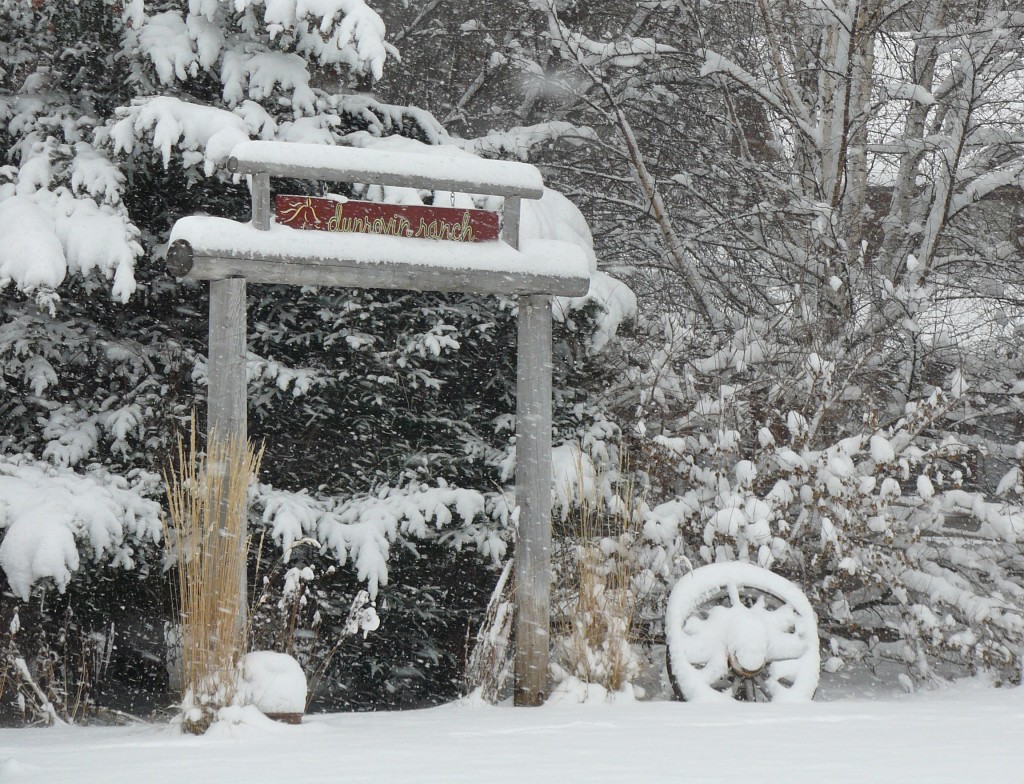A little slice of paradise!
Beautiful in both summer and winter!
Never intending to own a guest ranch, Sterling and SuzAnne Miller were delighted to find this beautiful little piece of Montana when they decided to return from Alaska to help care for SuzAnne’s parents. Then, Sterling’s large family began to gather at Dunrovin for reunions, and friends from Alaska migrated south to check out Montana as a potential retirement place. Naturally, this meant creating some guest quarters and purchasing a couple of guest horses so SuzAnne could take friends into the backcountry. Pretty soon a guest bedroom turned into several apartments and a couple of extra horses turned into a herd. Then, an innocent remark by a guest, “Why you have a little resort here!” started the ball rolling. Thus was born Dunrovin Ranch.
The DaysAtDunrovin (or D@D as some of us call it) community came into being when Dunrovin installed a web camera above the osprey nest located on the ranch. People gathered around their computers to watch the ospreys and became friends through chatting, emailing, Tweeting, and Facebooking. Soon, their interests spread from ospreys to the horses, then the donkeys, and then the dogs. People were so enchanted, we had to add additional web cameras so they could stay caught up with all the stories at the ranch!
Dunrovin Ranch is the product of evolution rather than purposeful development and planning. Dunrovin’s owners, SuzAnne and Sterling Miller, were somewhat surprised to find themselves as hosts for guest ranch visitors from around the world. They are scientists: Sterling is a wildlife biologist and SuzAnne is a biometrician (mathematics as applied to biological problems). They had enjoyed long professional careers with state, federal, and international natural resources management agencies before returning to SuzAnne’s home state of Montana in 1997. Initially they continued with their scientific work. Sterling worked for the National Wildlife Federation and SuzAnne consulted with many state and federal agencies.
SuzAnne, however, began to spend more and more time playing outdoors and less and less time in her office. Somehow SuzAnne’s love for back country adventures, horses and dogs (all animals, really), Montana, and a desire to share those loves with friends and family lead her down the trail to incrementally creating Dunrovin Ranch with Sterling’s blessing and assistance.

Much has happened since SuzAnne officially opened Dunrovin Ranch in 2005. Thousands of people from all over the world have come and gone, enriching the ranch in so many ways. Many animals have also passed through. For most, Dunrovin Ranch has been their "forever home" where they stayed and lived out their lives among friends. Special events, joyous weddings, theatrical performances, wild fires in the mountains with fire fighters staying in the ranch's pastures, the flooding and freezing river, late spring snowstorms, and endless fascination with the resident ospreys have all punctuated the years.
Thankful are we for the many voices, hard work, and loving care that so many have given us to make Dunrovin Ranch such a magical place. Long hot days the end with bright pick sunsets, BIG smiles on happy children's faces as they ride a pony, painting our equine partners to celebrate our bonds, the donkey DIVAS prancing about in the Christmas Parade, people learning how wonderfully smart and sentient our horse partners are, quiet moments in the mountain forests with the horses and guests from afar, and letting our curiosities lead us astray have been the order of the days at Dunrovin Ranch.
Dunrovin Ranch – a Bird’s Eye View
Dunrovin Ranch utilizes private, leased, and permitted state land for its operation. The GoogleEarth photo below indicates the property lines, the osprey nest pole, and the fishing locations most used by ospreys nesting at Dunrovin: the Bitterroot River, the lake, and local fish ponds.
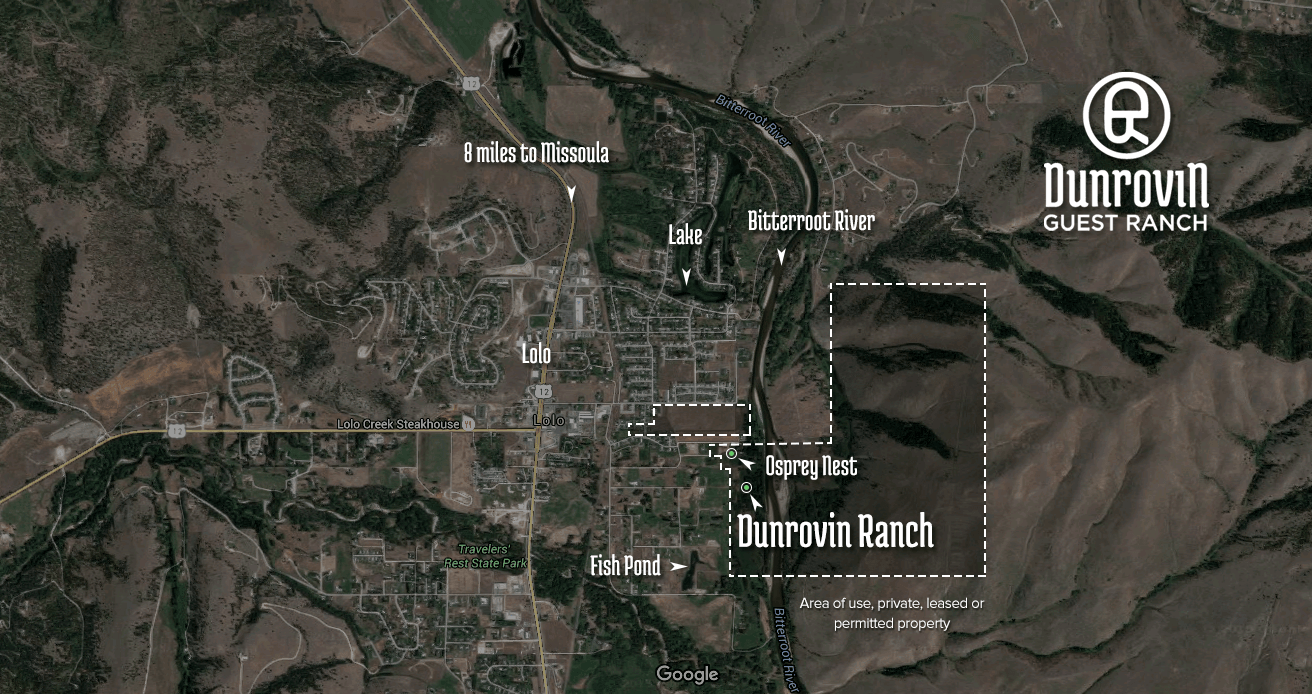
The view below shows the same area as seen from a low flying plane. If you look carefully, you will note the osprey nest and camera pole to the left of the red roof on Dunrovin’s barn and the ranch camera pole to the right and towards the river from the red roof.
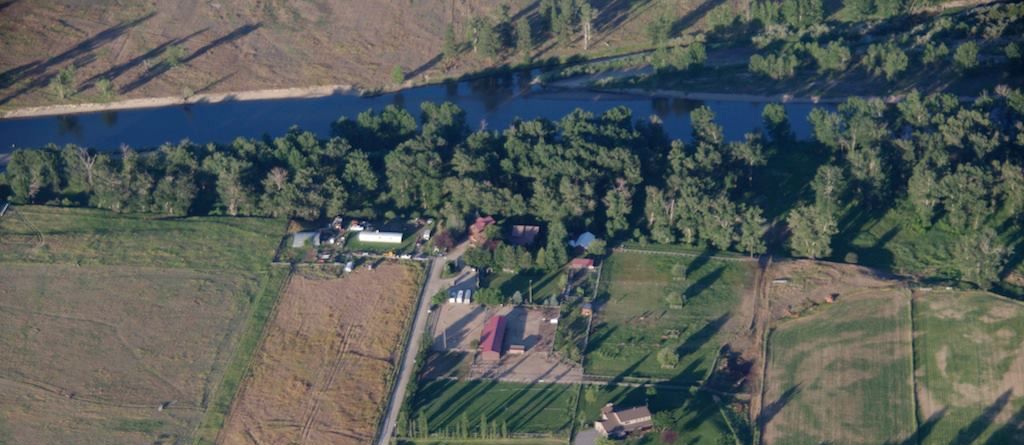
PLACES WITHIN THE RANCH
The Dunrovin Ranch staff has shorthand names for all of the different parts of the ranch. They use these names in charts for animals feeding, pasture rotations, irrigation, and activity planning. Our DaysAtDunrovin community members come to know there names as well. In fact, the names are often used during online games that involve members using the webcams to find clues that have been hidden around the ranch.


Visitors to Dunrovin Ranch frequently assume that Dunrovin is SuzAnne’s family name of Scottish origin. It’s a reasonable assumption.The similar sounding Dunrobin Castle is one of Glasgow’s most famous and beautiful fairy-tale castles. Alas, her family roots do not lead to Dunrobin castle. Rather, the name “Dunrovin” comes to SuzAnne from her great grandmother’s love of Montana.
As a young woman in the 1880s, her great grandmother, Clara, and her husband, Harry, lived in a log cabin along Carpenter Creek near the mining town of Neihart in Montana’s Big Belt Mountains. There, she gave birth to SuzAnne’s grandmother, Gertrude. Circumstances, however, forced the family to leave Montana and return to the Midwest where, with the proceeds from his Montana mining adventures, Harry built a mansion on banks of the Mississippi River.
Harry was clearly a risk taker – something he and SuzAnne seem to share. Unfortunately, his risk taking got him into significant financial trouble (let’s hope this is where the ancestral comparison ends!) and he lost his fortune. Ashamed of his losses, Harry literally abandoned his now very large family and fled to the woods of Wisconsin (here the ancestral comparison definitely ends!). Left with seven children and a huge house, Clara did the only sensible thing: she piled the family into one bedroom and opened a boarding house. She remained there until the last child left home and she was free to follow her own muse –Montana.
Gertrude and two of her sisters had already been lured back to Montana by the time Clara was free to find her way back to the tiny settlement of cabins along Carpenter Creek. Upon arrival, she declared that she was “Dun Rovin’” – she never meant to leave Montana and she was back to stay. A “Dun Rovin” sign was fashioned from wood and nailed above the front door.
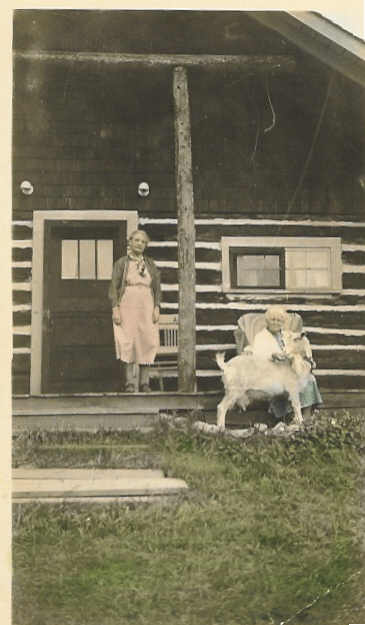
As a child, SuzAnne spent many wonderful summer days (and a few winter days) with her grandmother at Dun Rovin. Her heart is full with memories of long summer days hiking the hills, picking wild raspberries, fishing the streams, and sleeping on the screened-in porch during wild thunderstorms. Best of all, they searched the old mining town dumps for fancy colored glass bottles. Grandma and she gathered a collection of perfume and oil bottles that they kept in a beautiful wooden steamer chest with multiple compartments. That chest with it amber, sage, and azure colored bottles is still vivid in SuzAnne’s mind. Oh, to have it today!
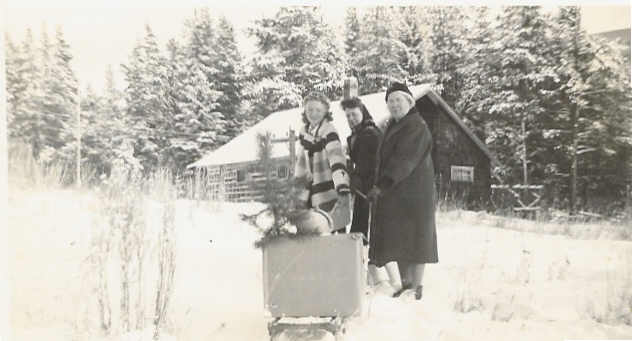
Those Montana memories were always fresh in SuzAnne’s heart and mind as she moved about the world: Seattle for graduate school, Chile for three years with the Peace Corps, and Alaska for over twenty years of working with natural resource agencies. Montana remained her real home throughout those years. Once her aging parents required assistance and SuzAnne and Sterling could retire from their positions, they turned their family towards that Montana home. SuzAnne too was “dun rovin” and immediately gave the name Dunrovin to their little piece of heaven along the Bitterroot River.
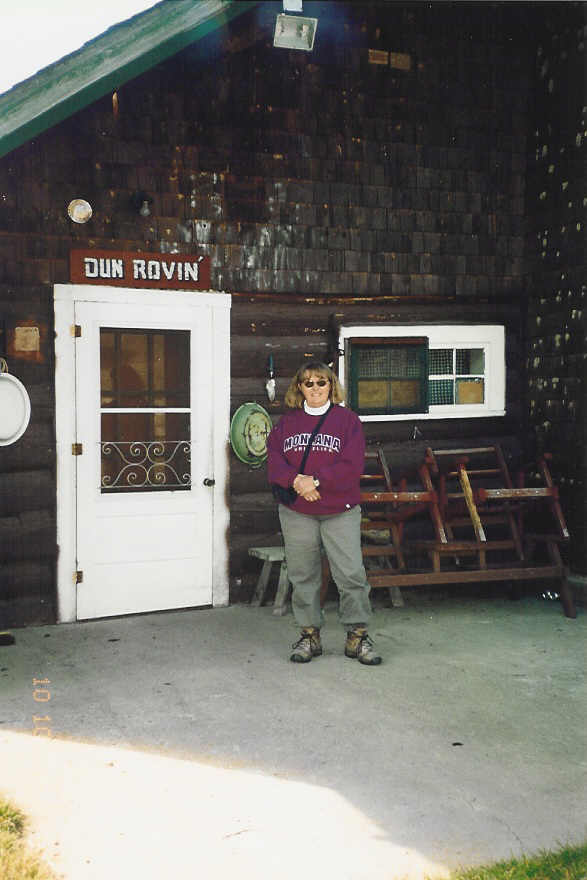
Within a few months of her family’s return to Montana and SuzAnne tacking up her own “Dunrovin” sign, SuzAnne received a book in the mail from a distant relative, which told the story of her great-grandmother and the naming of the Dun Rovin cabin. In that book, for the first time, SuzAnne saw a picture of her great-grandmother Clara with “her fancy gaited horse, Lady.” Clearly, this acorn fell close to the family tree: SuzAnne now has her own “fancy, gaited horse,” Lady Lonza, named after Clara’s grandson (SuzAnne’s father), William Lonzo Goodman.
Several years ago, SuzAnne drove back to see if the old cabin was still standing. Her family had sold it when her grandmother died. She found the cabin and left her business card taped to the door, asking the owners if they would be interested in letting her rent the cabin some day. About a month later, she received a call from the wonderful Great Falls couple who owned the cabin. They invited her to come and stay as long as she liked. What a great response to a person (SuzAnne) who had clearly trespassed on their property! It gave SuzAnne yet another reason to be delighted to be back in her home state where people still trusted each other.
The stunning Bitterroot Valley extends nearly 100 miles south from Missoula into Lost Trail Pass on the Montana – Idaho border. The entire Valley is lined with mountains on either side – to the west is the Bitterroot Range and the large Selway-Bitterroot Wilderness Area; to the east you will find the smaller Sapphire Mountains and the Anaconda-Pintler Wilderness Area. On the west side of the valley are numerous deeply-carved granite canyons, such as the scenic Blodgett Canyon and Bass Creek Canyon. Trapper Peak is the highest point in the “Bitterroots,” at more than 10,150 ft. in elevation and provides a dramatic punctuation to the southern end of this valley. Highway 93 is the major north-south highway running through the center of Bitterroot Valley, offering some of the America’s most scenic highway vistas.
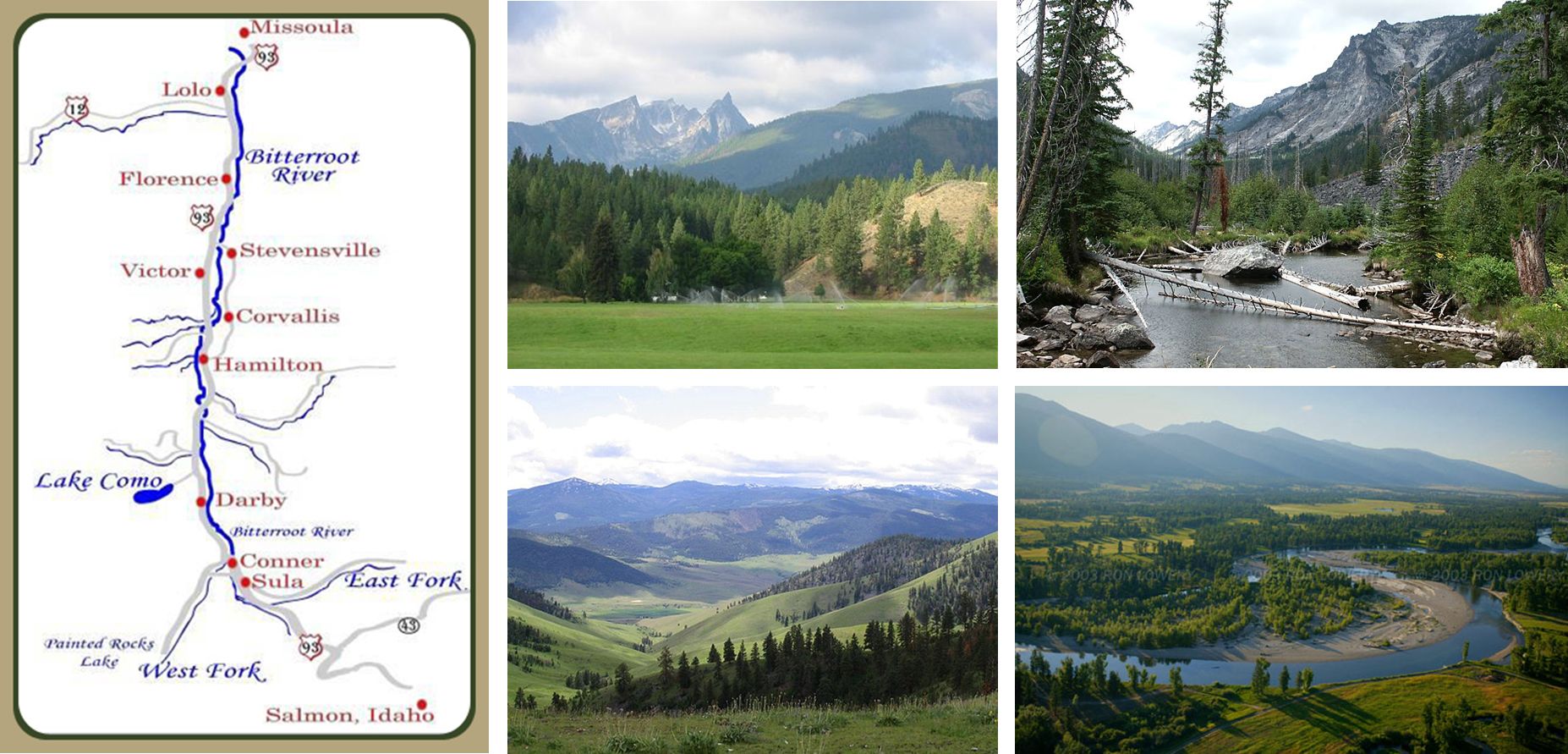 The wide mostly flat valley bottom is known for its fertility and relatively moderate climate and supports a number of ranches and farms that work hard to feed local Montanans. Along the length of the valley, the Bitterroot River ripples and curves, offering blue ribbon fishing, as well as float trips in the summer months. The terrain of the Bitterroot Valley changes considerably between the northern and southern portions. The northern end is quite flat and open. It is considerably wider than the southern portion with beautiful panoramic views overlooking hay fields and towns, all with beautiful mountain backdrops. The southern end narrows and is barely five miles wide. The Bitterroot River splits into the East and West Forks and you have more trees and close-up views of mountains, rock formations and wildlife.
The first settled community in the valley sprung to life when St. Mary’s Mission was established in 1841 and followed shortly by Fort Owen—around 1850. This early establishment quickly evolved into what is now the vibrant community of Stevensville. Soon after, other early settlements began to spring up and down the valley located about a day’s horseback ride apart. These settlements have all evolved into friendly, little communities that are unique centers for outdoor recreation, festivals, and high quality living. From north to south and starting with our own community, you will find:
The wide mostly flat valley bottom is known for its fertility and relatively moderate climate and supports a number of ranches and farms that work hard to feed local Montanans. Along the length of the valley, the Bitterroot River ripples and curves, offering blue ribbon fishing, as well as float trips in the summer months. The terrain of the Bitterroot Valley changes considerably between the northern and southern portions. The northern end is quite flat and open. It is considerably wider than the southern portion with beautiful panoramic views overlooking hay fields and towns, all with beautiful mountain backdrops. The southern end narrows and is barely five miles wide. The Bitterroot River splits into the East and West Forks and you have more trees and close-up views of mountains, rock formations and wildlife.
The first settled community in the valley sprung to life when St. Mary’s Mission was established in 1841 and followed shortly by Fort Owen—around 1850. This early establishment quickly evolved into what is now the vibrant community of Stevensville. Soon after, other early settlements began to spring up and down the valley located about a day’s horseback ride apart. These settlements have all evolved into friendly, little communities that are unique centers for outdoor recreation, festivals, and high quality living. From north to south and starting with our own community, you will find:
- Lolo, home of Travelers’ Rest Montana State Park, the Lolo Square Dance Center, Lolo Hot Springs, and the best steak in all of Montana at Lolo Creek Steak House
- Florence, location of one of our favorite Italian Restaurants, Caffé Firenze
- Stevensville, Montana’s oldest European settlement celebrates its agricultural heritage each year with the Northwest Honey Fest
- Victor, where they annually celebrate their namesake, Chief “Plenty of Horses” Victor
- Corvallis, home of the Teller Wildlife Refuge
- Hamilton, a bustling little city that boasts one of the nation’s leading research labs, the Rocky Mountain Laboratories
- Darby, know for it logging history which they celebrate every year during Logger Days
- Conner and Sula both serve as gateways to Lost Trail Pass, one of Montana’s favorite places for both downhill and cross county skiing, and Lost Trail Hot Springs.
The Bitterroot River
 The Bitterroot River is a wide artery of free flowing, clear water, winding over 80 miles from the Bitterroot Mountains to its confluence with the Clark Fork River in Missoula.
Internationally known as a blue ribbon fly fishing river, the Bitterroot’s many riffles, deep pools, fallen trees, and seasonal hatches make it one of Montana’s most popular fly-fishing destinations. Anglers enjoy a long season wrangling cutthroat, brown, rainbow, and brook trout beginning in early March and extending through November. To cast your line a little further, check out our partner Grizzle Hackle who will happily take you on a guided float or wade trip. Be sure to visit Montana Fish, Wildlife, and Parks Field Guide for information on all the fish that can be found in the Bitterroot River.
The Bitterroot River is a wide artery of free flowing, clear water, winding over 80 miles from the Bitterroot Mountains to its confluence with the Clark Fork River in Missoula.
Internationally known as a blue ribbon fly fishing river, the Bitterroot’s many riffles, deep pools, fallen trees, and seasonal hatches make it one of Montana’s most popular fly-fishing destinations. Anglers enjoy a long season wrangling cutthroat, brown, rainbow, and brook trout beginning in early March and extending through November. To cast your line a little further, check out our partner Grizzle Hackle who will happily take you on a guided float or wade trip. Be sure to visit Montana Fish, Wildlife, and Parks Field Guide for information on all the fish that can be found in the Bitterroot River.
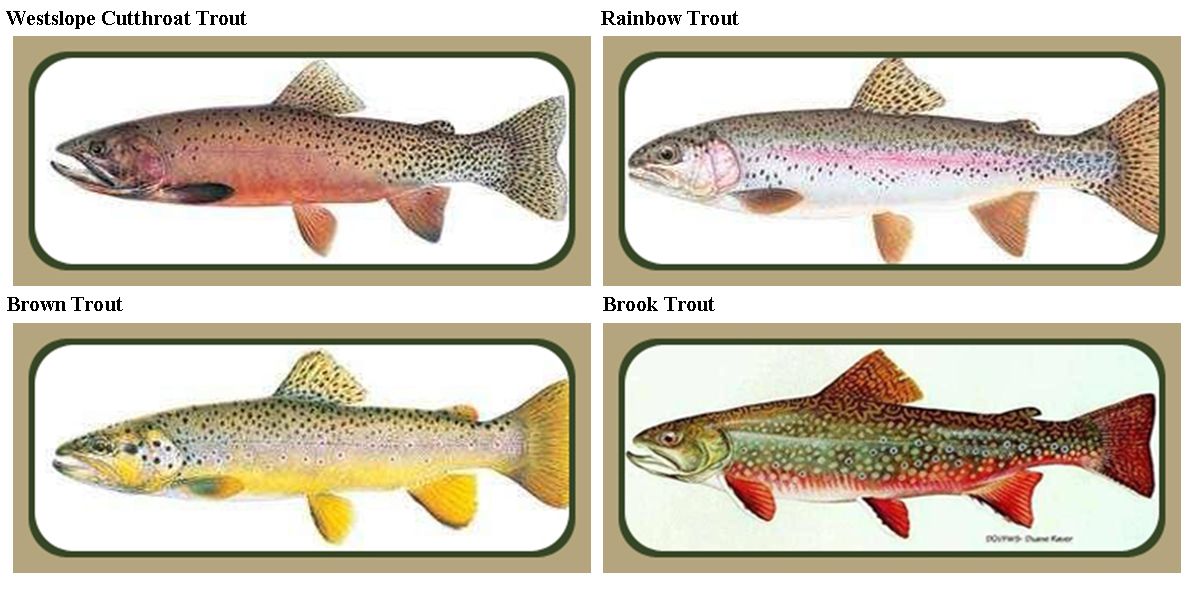 Dunrovin’s favorite term for the Bitterroot River is friendly. Except during the high spring run-off, the Bitterroot’s gentle flow and crystal clear water is perfect for long, lazy summer floats whether incanoe, drift boat, raft, or inner tube. The enticing, cool water is irresistible in the heat of the afternoon and picnicking on one of the numerous sandy beaches or gravel bars is the perfect reprieve.
Dunrovin Ranch has its own swimming pool, complete with sandy beach and shady trees—carved out by an old channel of the river. We call it “Dunflowin” to denote its still, spring waters – cool and deep. There is no other place to be on a hot summer day!
The excellent habitat of the Bitterroot River and its riparian corridor provides Dunrovin’s guests with ample opportunity to view wildlife. The Bitteroot Birding and Nature Trail guides visitors through some of the valley’s most vibrant bird habitat and nature viewing areas and the Montana Natural History Center offers tours lead by local naturalists.
Dunrovin offers guided canoe trips with plenty of time for swimming, wildlife viewing, and picnicking in some of Montana’s most scenic country.
Dunrovin’s favorite term for the Bitterroot River is friendly. Except during the high spring run-off, the Bitterroot’s gentle flow and crystal clear water is perfect for long, lazy summer floats whether incanoe, drift boat, raft, or inner tube. The enticing, cool water is irresistible in the heat of the afternoon and picnicking on one of the numerous sandy beaches or gravel bars is the perfect reprieve.
Dunrovin Ranch has its own swimming pool, complete with sandy beach and shady trees—carved out by an old channel of the river. We call it “Dunflowin” to denote its still, spring waters – cool and deep. There is no other place to be on a hot summer day!
The excellent habitat of the Bitterroot River and its riparian corridor provides Dunrovin’s guests with ample opportunity to view wildlife. The Bitteroot Birding and Nature Trail guides visitors through some of the valley’s most vibrant bird habitat and nature viewing areas and the Montana Natural History Center offers tours lead by local naturalists.
Dunrovin offers guided canoe trips with plenty of time for swimming, wildlife viewing, and picnicking in some of Montana’s most scenic country.
The Lewis and Clark Expedition
The wild terrain and striking beauty of the Bitterroot Valley has held travelers in reverence since the days of Lewis and Clark. The Corps of Discovery entered the area in the fall of 1805 through the southern part of the valley, at Lost Trail Pass. From there, they traveled north toward present day Missoula to the confluence of Lolo creek and the Bitterroot River. At this juncture, which was named Traveler’s Rest, the Corps of Discovery turned westward once more, to cross over the Bitterroot Range through Lolo Pass—following Lolo Creek and the Nez Perce Trail. In July of 1806 the Corps of Discovery visited Traveler’s Rest again on their return journey eastward. At that time, the group split into two; with Lewis headed northeast and Clark south, for further discovery. At many places in “The Bitterroot,” visitors can read roadside signs that illustrate Lewis and Clark’s movement through the valley. Yet, most don’t suspect that Dunrovin Ranch has one of these markers on its property that actually provides incorrect information identifying the location of Travelers Rest, which is now a state park. Fortunately, this was a short-lived mistake and Traveler’s Rest State Parkhas been correctly identified 1.3 miles west of the ranch.
The Traveler’s Rest Preservation and Heritage Association has been a driving force in helping Traveler’s Rest State Park develop a museum and visitor’s site that tell the compelling story of the Corps of Discovery. Bill and Ramona Holt of the Holt Heritage Museum have been particularly supportive and instrumental in making Traveler’s Rest the center of Lolo and bringing the story of Lewis and Clark to visitors and residents alike.
Dunrovin Ranch owners, Sterling and SuzAnne Miller, have long been ardent fans of Lewis and Clark, marveling at their courage and leadership. The more they learned, the more impressed they were. It is nearly impossible not to be awed by their achievement. They lost only one person to sickness during their two year journey. They sought and obtained friendship and assistance from most of the American Indian tribes they encountered, with only one hostile encounter that ended in an Indian fatality. Their scientific findings and measurements were rigorous and invaluable in understanding the country through which they traveled, and their sense of geography coupled with their just and confident leadership of the corps made the expedition successful. One of the Miller’s favorite places for finding information about them is Discovering Lewis and Clark.
Dunrovin Ranch strives to emulate the characteristics so aptly demonstrated by the Corps of Discovery by celebrating courage to explore new territory with a sense of scientific and cultural curiosity and respect, fostering a connection with local residents for better understanding of place, demonstrating a focus on the safety of all involved, and approaching the natural world with a sense of awe.
At many places in “The Bitterroot,” visitors can read roadside signs that illustrate Lewis and Clark’s movement through the valley. Yet, most don’t suspect that Dunrovin Ranch has one of these markers on its property that actually provides incorrect information identifying the location of Travelers Rest, which is now a state park. Fortunately, this was a short-lived mistake and Traveler’s Rest State Parkhas been correctly identified 1.3 miles west of the ranch.
The Traveler’s Rest Preservation and Heritage Association has been a driving force in helping Traveler’s Rest State Park develop a museum and visitor’s site that tell the compelling story of the Corps of Discovery. Bill and Ramona Holt of the Holt Heritage Museum have been particularly supportive and instrumental in making Traveler’s Rest the center of Lolo and bringing the story of Lewis and Clark to visitors and residents alike.
Dunrovin Ranch owners, Sterling and SuzAnne Miller, have long been ardent fans of Lewis and Clark, marveling at their courage and leadership. The more they learned, the more impressed they were. It is nearly impossible not to be awed by their achievement. They lost only one person to sickness during their two year journey. They sought and obtained friendship and assistance from most of the American Indian tribes they encountered, with only one hostile encounter that ended in an Indian fatality. Their scientific findings and measurements were rigorous and invaluable in understanding the country through which they traveled, and their sense of geography coupled with their just and confident leadership of the corps made the expedition successful. One of the Miller’s favorite places for finding information about them is Discovering Lewis and Clark.
Dunrovin Ranch strives to emulate the characteristics so aptly demonstrated by the Corps of Discovery by celebrating courage to explore new territory with a sense of scientific and cultural curiosity and respect, fostering a connection with local residents for better understanding of place, demonstrating a focus on the safety of all involved, and approaching the natural world with a sense of awe.

